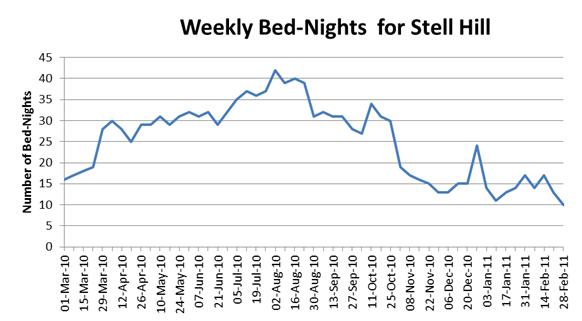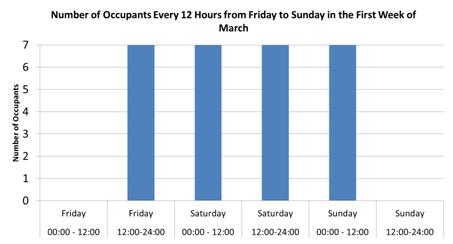
Project Overview
Construction
Occupancy
Behavioural models
Demand
Renewable technologies
Conclusion
Team
Acknowledgements
Occupancy
Craik Occupancy Profiles
From the weekly bed-occupancy rate calculated from Oban, Strathyre and Visit Scotland, we have made the following assumptions:
1st Assumption:
Accommodation would be fully occupied or empty. In other words, if the house can accommodate a maximum of 3 bed-nights per day, it would have 3 bed-nights or no people at all in a particular day.
For our case study, a house (Stell Hill) can accommodate a maximum of 7 bed-nights per night. We calculated the number of bed-nights per week from the above assumption by multiplying the weekly bed-occupancy rate by the maximum bed nights per week for Stell Hill:
Number of Bed Nights per Week = Weekly Bed-Occupancy Rate x 49 (Maximum Bed Nights per Week)
Therefore, bed night will be the measure of occupancy for one person for one night. Then, we could know the number of bed-nights per week.
The graph below shows the weekly number of bed-nights for Stell Hill (7 people accommodation.

2nd Assumption:
Occupants would tend to stay in this accommodation during the weekend rather than the weekdays according to the weekday/weekend occupancy rate taken from hotels and hostels in Scottish Accommodation Occupancy Survey 2009*. Especially in our case study, that it is only suitable for holiday and not for business purpose. Hence people would choose to come over the weekend before weekdays.
Based on the previous assumptions, we allocated the weekly number of bed-nights to weekends before weekdays for each week during one year period. The graph below shows an example of the number of daily occupants in March.

From the bar graph above, occupants would stay in the house for 2 days in the first week. According to this graph, occupants would arrive at 00:01am on Saturday and leave at 23:59pm on Sunday. In reality, they would arrive around Friday afternoon and leave around Sunday afternoon. The following assumption would take this into consideration.
3rd Assumption:
Occupants would arrive at 12:00am (check-in) and also leave at 12:00am (check-out). The staying period of the occupants was shifted 12 hours earlier to make more realistic the occupancy period. However, the number of bed nights would still be the same according to our weekly bed-occupancy rate. The graph below illustrates the distribution of the occupancy from Friday to Sunday in the first week of March.

